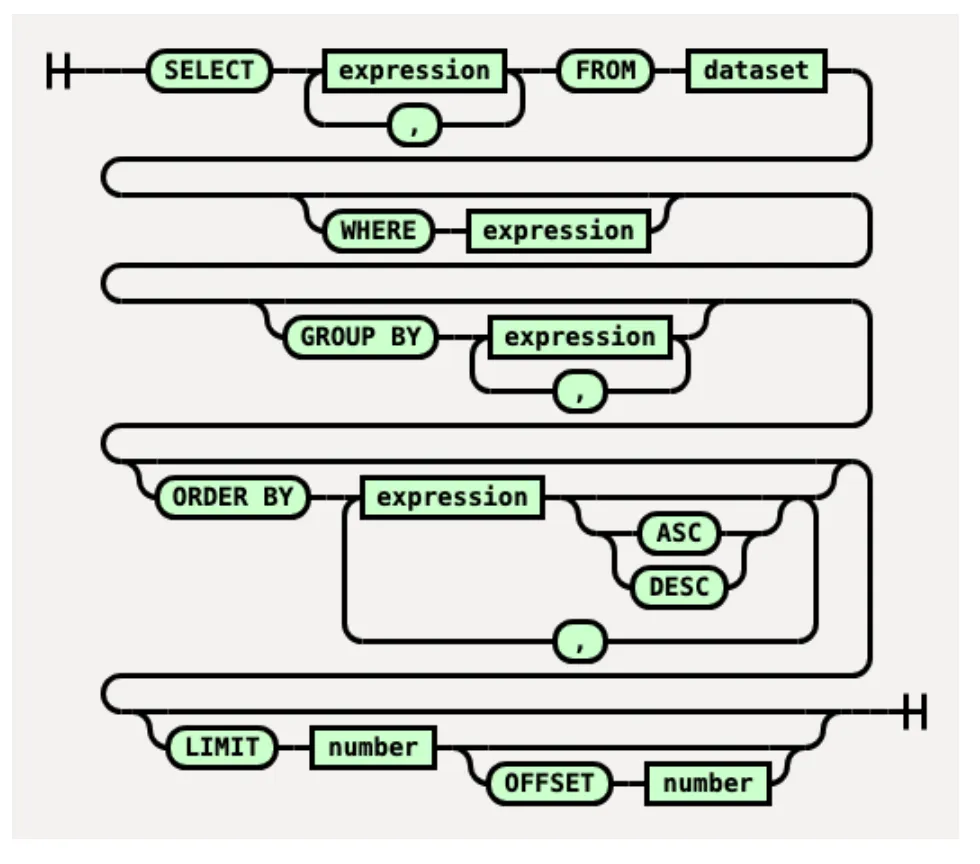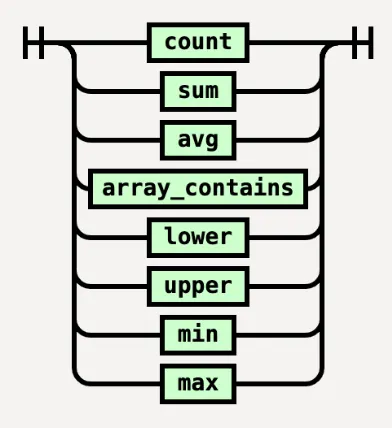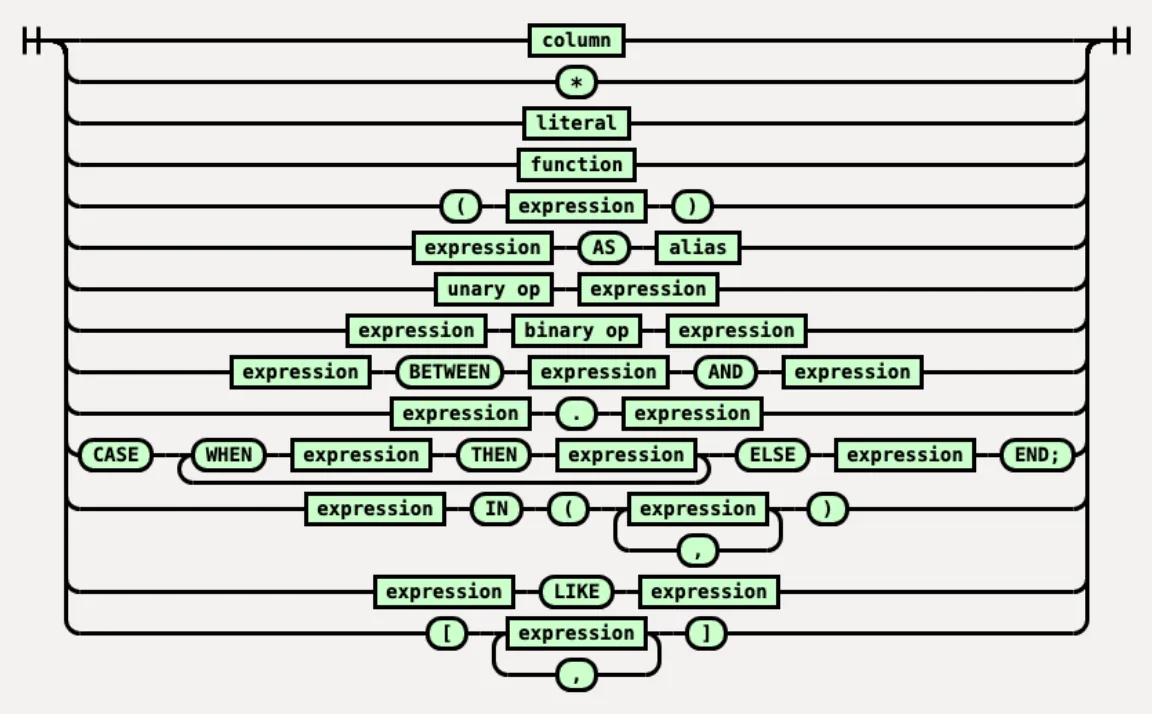SQL queries supported
This page outlines the SQL features supported by Log Explorer, including common aggregation functions, expressions, and query clauses.
The diagram below illustrates the general shape of a valid query supported in Log Explorer. It shows how standard SQL clauses — such as SELECT, WHERE, GROUP BY, and ORDER BY — can be composed to form supported queries.

Examples of queries include:
SELECT * FROM table WHERE (a = 1 OR b = "hello") AND c < 25.89SELECT a, b, c FROM table WHERE d >= "GB" LIMIT 10
The following SQL clauses define the structure and logic of queries in Log Explorer:
SELECT- TheSELECTclause specifies the columns that you want to retrieve from the database tables. It can include individual column names, expressions, or even wildcard characters to select all columns.FROM- TheFROMclause specifies the tables from which to retrieve data. It indicates the source of the data for theSELECTstatement.WHERE- TheWHEREclause filters the rows returned by a query based on specified conditions. It allows you to specify conditions that must be met for a row to be included in the result set.SELECT DISTINCT- Removes duplicate rows from the result set.GROUP BY- Groups rows for aggregation. TheGROUP BYclause is used to group rows that have the same values into summary rows.ORDER BY- Sorts the result set. TheORDER BYclause is used to sort the result set by one or more columns in ascending or descending order.LIMIT- Restricts the number of rows returned. TheLIMITclause is used to constrain the number of rows returned by a query. It is often used in conjunction with theORDER BYclause to retrieve the topNrows or to implement pagination.OFFSET- Skips a specified number of rows before returning results.
The sections that follow break down the remaining components shown in the diagram — such as aggregation functions, string and numeric expressions, and supported operators — in more detail.
Log Explorer supports a range of SQL functions to transform, evaluate, or summarize data. These include scalar and aggregation functions.
These help manipulate or evaluate values (often strings):
-
ARRAY_CONTAINS(array, element)– Checks if the array contains the element.Example
ARRAY_CONTAINS(['US', 'CA'], ClientCountry)Returns rows where
ClientCountryis eitherUSorCA. -
SUBSTRING(string, from_number, for_number)– Extracts part of a string.Example
SUBSTRING(ClientRequestPath, 0, 5)Extracts the first
5characters fromClientRequestPath. -
LOWER(string)– Converts to lowercase.Example
LOWER(ClientRequestUserAgent)Converts the user agent string to lowercase.
-
UPPER(string)– Converts to uppercase.Example
UPPER(ClientCountry)Converts the country code to uppercase.
Used to perform calculations on sets of rows:
-
SUM(expression)– Total of values.Example
SUM(ClientRequestBytes)Adds up the total number of bytes requested by clients.
-
MIN(expression)– Minimum value.Example
MIN(OriginResponseDurationMs)Finds the shortest response time from origin servers.
-
MAX(expression)– Maximum value.Example
MAX(OriginResponseDurationMs)Finds the longest response time.
-
COUNT(expression)– Number of rows (can be all rows or non-null values).Example
COUNT(ClientRequestUserAgent)Counts how many rows have a user agent value.
-
COUNT(DISTINCT expression)– Number of distinct non-null values.Example
COUNT(DISTINCT ClientIP)Counts how many unique client IPs made requests.
-
AVG(expression)– Average of numeric values.Example
AVG(OriginResponseDurationMs)Computes the average origin response time in milliseconds.
The diagram below represents the grammar for SQL expressions including scalar and aggregate functions.

Conditions or logic used in queries:
CASE WHEN– Conditional logic (like if-else).AS– Alias for columns or tables.LIKE– Pattern matching.IN (list)– Checks if a value is in a list.BETWEEN ... AND ...– Checks if a value is within a range.Unary operator– Operates on one operand (for example,-5).Binary operator– Operates on two operands (for example,5 + 3).Nested Expressions– Expression wrapped with parentheses, like( x > y )or( 1 ).Compound identifier– Multi-part name (for example,schema.table.column).Array– A collection of values (supported differently across SQL dialects).Literals- represent values such as strings, numbers, or arrays.
The diagram below represents the grammar for SQL expressions, detailing the various forms an expression can take, including columns, literals, functions, operators, and aliases.

The diagram below defines the grammar for unary operators, which operate on a single operand (for example, negation or logical NOT):

Used for arithmetic, comparison, logical operations:
- Arithmetic:
+,-,*,/,%(modulo) - Comparison:
>,<,>=,<=,=,!=(or<>)` - Logical:
AND,OR,XOR - Bitwise:
&,|,^,>>,<< - String concat:
||
Was this helpful?
- Resources
- API
- New to Cloudflare?
- Products
- Sponsorships
- Open Source
- Support
- Help Center
- System Status
- Compliance
- GDPR
- Company
- cloudflare.com
- Our team
- Careers
- © 2025 Cloudflare, Inc.
- Privacy Policy
- Terms of Use
- Report Security Issues
- Trademark